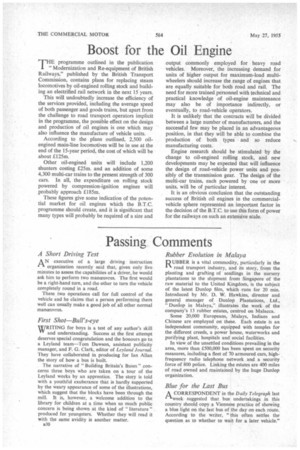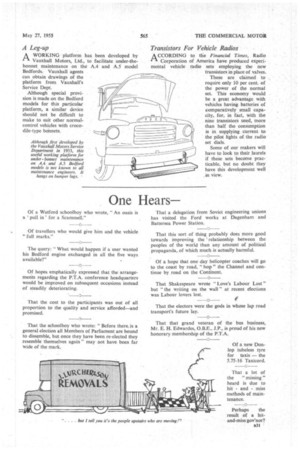Passing Comments
Page 38

Page 39

If you've noticed an error in this article please click here to report it so we can fix it.
A Short Driving Test Rubber Evolution in Malaya
A N executive of a large driving instruction
organization recently said that, given only five minutes to assess the capabilities of a driver, he would ask him to perform two manceuvres. The first would be a right-hand turn, and the other to turn the vehicle completely round in a road.
These two operations call for full control of the vehicle and he claims that a person performing them well can usually make a good job of all other normal manceuvres.
First Shot—Bull's-eye
WRITING for boys is a test of any author's skill " and understanding. Success at the first attempt deserves special congratulation and the honours go to a Leyland team—Tom Dawson, assistant publicity manager, and F. G. Clark, editor of Leyland Journal. They have collaborated in producing for Ian Allan the story of how a bus is built.
The narrative of "Building Britain's Buses" concerns three boys who are taken on a tour of the Leyland works by an apprentice. The story is told with a youthful exuberance that is hardly supported by the weary appearance of some of the illustrations, which suggest that the blocks have been through the mill. It is, however, a welcome addition to the library for children at a time when so much public concern is being shown at the kind of " literature " produced for youngsters. Whether they will read it with the same avidity is another matter.
a30 NOUBBER is a vital commodity, particularly in the " road transport industry, and its story, from the planting and grafting of seedlings in the nursery plantations to the shipment from Singapore of the raw material to the United Kingdom, is the subject of the latest Dunlop film, whiCh runs for 20 min. Introduced by Mr. D. W. Hawkins, director and general manager of Dunlop Plantations, Ltd., "Dunlop in Malaya," illustrates the work of the company's 13 rubber estates, centred on Malacca.
Some 20,000 Europeans, Malays, Indians and Chinese are employed on these. Each estate is an independent community, equipped with temples for the different creeds, a power house, waterworks and purifying plant, hospitals and social facilities.
In view. of the unsettled conditions prevailing in the area, more than 000,000 has been spent on security measures, including a fleet of 70 armoured cars, highfrequency radio telephone network and a security force of 800 police. Linking the estates are 400 miles of road owned and maintained by the huge Dunlop organization.
Blue for the Last Bus
ACORRESPONDENT in the Daily Telegraph last week suggested that bus undertakings in this country should copy a Viennese practice of showing a blue light on the last bus of the day on each route. According to the writer, "this often settles the question as to whether to wait for a later vehicle."
A Leg-up
A WORKING platform has been developed by r-sVauxhall Motors, Ltd., to facilitate under-thebonnet maintenance on the A.4 and A.5 model Bedfords. Vauxhall agents can obtain drawings of the platform from Vauxhall's Service Dept.
Although special provision is made on the Bedford models for this particular platform, a similar device should not be difficult to make to suit other normalcontrol vehicles with crocodile-type bonnets_
Transistors For Vehicle Radios
ACCORDING to the Financial Times, Radio Corporation of America have produced experimental vehicle radio sets employing the new transistors in place of valves.
These are claimed to require only 10 per cent. of the power of the normal set. This economy would be a great advantage with vehicles having batteries of gornparatively small capacity, for, in fact, with the nine transistors used, more than half the consumption is in supplying current to the pilot lights of the radio set dials.
Some of our makers will have to look to their laurels if these sets become practicable, but no doubt they have this development well in view.








































































































